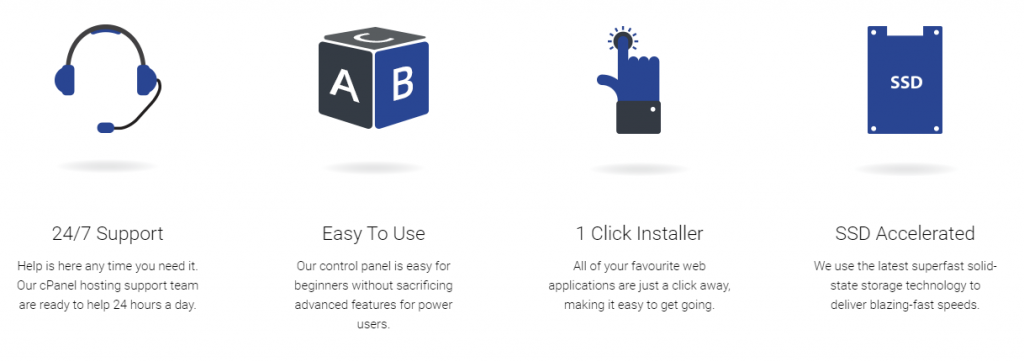Whatever type of business you run, it’s important to have a professional website. It is often the first impression a visitor gets of your business and they may judge the quality of your services by what they see on their screens. If your site looks unprofessional, they are less likely to become customers. Creating a professional website doesn’t mean it has to be professionally built. You don’t need to pay a developer to do the job for you. What you will need to do is ensure it has the features we mention here.
- A clean, uncluttered layout
Visitors expect a website to make things easy for them. When they come across a site with cluttered, busy-looking pages, the thought of having to wade through the content to find what they are looking for can seem like an unnecessary hassle. The same applies to badly laid out pages with mismatching colours and awkwardly placed images, where content is not presented in a uniform, structured way. When visitors find sites like these, many will quickly leave and take their custom with them.
Professional websites are easy on the eye. This makes it easier for visitors to find the relevant information on the page and take it in. The starting point for this is to choose a clean looking theme and then to make sure that the content of is laid out effectively. To achieve this, you’ll need to declutter unnecessary content, use lots of white space and have easy to read fonts of the right letter size and line space. The information on the page needs to be logically structured and organised into discrete sections, perhaps using a small palette of matching background colours. There will be clear, relevant titles and subheadings and, where appropriate, carefully placed, high-quality images. Here is one section of our cPanel web hosting page.
- A user-friendly experience
Nothing on your website should be difficult to find or do. The more obstacles you put in the customers way, the more of them will fall by the wayside before they buy your goods or services.
It is important to make navigating your site simple. There are two elements to this. First, you need to make sure your content is on the right pages and that pages and posts are in the relevant sections or categories. Once the content is logically structured, you then need to make sure that there are easy ways to find it. This means building a straightforward, simple to use menu that is clearly visible on the screen. If you have a large site, you’ll also need a search bar. eCommerce stores should use filtered search tools that let customers search for items and then narrow the results down by filtering for things like price, colour, size, etc. Navigation can also be improved by including internal links in pages and in the footer section of the website.
Ease of use goes beyond navigation. It also means that any actions a customer needs to take are simple to do. This includes things like following a call to action, filling in forms, subscribing and unsubscribing, adding to and viewing a shopping cart, getting in touch and, very importantly, checking out. Making it easy means putting things in obvious places, reducing the number of steps a customer needs to take, asking visitors to input as little information as possible and making it crystal clear to the customer what they need to do. - Well-written copy
People visit your website to find information about your business and it’s that information which will determine whether they use your company or not. Much of that content will be textual and when the copy is badly written, it can have a negative impact on your sales.
The first step is to make sure that your content is error-free. While poor grammar, spelling and punctuation affect the clarity and meaning of your content, perhaps its biggest impact is that it looks unprofessional. From a visitor’s point of view, if a company cannot spell, punctuate or use grammar correctly, its employees are either poorly-educated or aren’t prepared to go to the effort. Either way, it does not inspire confidence that your company will carry out its services in a professional manner.
Beyond that, well-written copy explains, describes, directs and informs in ways that are easy to understand. The content is written for your intended audience and for specific purposes and uses a voice that reflects the type of company you are. Moreover, it will balance professionalism and friendliness while persuading your visitors that your company is the right choice for them. - High performance
What’s under the bonnet is often just as important as what the customer sees on the screen. If the performance of your website is poor, it will load slowly on users’ browsers. This has been proven to increase the numbers of visitors who will abandon your website. It is widely believed that a mere one-second delay in loading time can cut conversions by 7%.
You can test the speed of your website and find out what’s slowing it down using Google’s free PageSpeed Insights tool. Other ways to boost performance include using a lightweight theme, deleting unnecessary plugins, optimising images, caching, compression and content delivery networks.
Another key factor in your website’s performance is your choice of hosting. Cloud-based shared hosting, like our SSD-powered cPanel packages, is far faster than traditional shared hosting. VPS hosting, on the other hand, offers you even greater resources so that your site can load quickly even when you have a lot of traffic. - Mobile-friendly design
Today, UK users spend twice as much internet time on mobile phones as they do on computers. Indeed, with nearly everyone having a smartphone, it is predicted that by 2024, mobile shopping will account for 40% of all UK internet spending. This growth, which is happening globally, means it’s never been so important to create a site that looks as professional on a mobile device as it does on a computer.
While a responsive theme that can display on any device is an absolute must, the best solution is that, when creating your website, you start by developing it for mobiles. This will ensure it looks good on a smartphone and, importantly, that features such as images, buttons, menus, forms and search bars are optimised for the small screen and that inputting, scrolling and clicking is easily done with a thumb.
Conclusion
Having a professional website can have a huge impact on your business. It speaks volumes about your company’s professionalism and the effort you have gone to make the site and its content easy to access, understand and take action on, regardless of the device on which it is being viewed. Hopefully, the advice given here will help you make improvements to your site.
For more information about our cloud-based cPanel shared hosting and VPS hosting solutions, visit our homepage.

